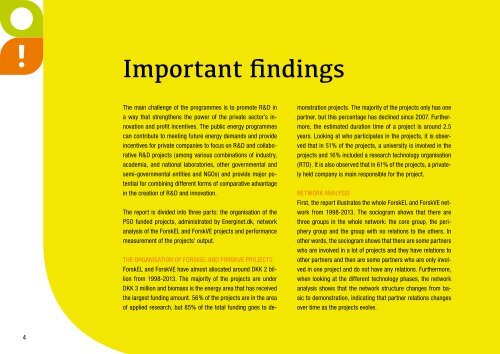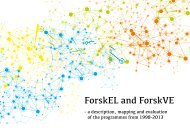ForskEL - Farmhouse Design
Design af rapport. Lavet af Farmhouse Design
Design af rapport.
Lavet af Farmhouse Design
Create successful ePaper yourself
Turn your PDF publications into a flip-book with our unique Google optimized e-Paper software.
Important findings<br />
The main challenge of the programmes is to promote R&D in<br />
a way that strengthens the power of the private sector’s innovation<br />
and profit incentives. The public energy programmes<br />
can contribute to meeting future energy demands and provide<br />
incentives for private companies to focus on R&D and collaborative<br />
R&D projects (among various combinations of industry,<br />
academia, and national laboratories, other governmental and<br />
semi-governmental entities and NGOs) and provide major potential<br />
for combining different forms of comparative advantage<br />
in the creation of R&D and innovation.<br />
The report is divided into three parts: the organisation of the<br />
PSO funded projects, administrated by Energinet.dk, network<br />
analysis of the <strong>ForskEL</strong> and ForskVE projects and performance<br />
measurement of the projects’ output.<br />
The organisation of <strong>ForskEL</strong> and ForskVE projects<br />
<strong>ForskEL</strong> and ForskVE have almost allocated around DKK 2 billion<br />
from 1998-2013. The majority of the projects are under<br />
DKK 3 million and biomass is the energy area that has received<br />
the largest funding amount. 56% of the projects are in the area<br />
of applied research, but 85% of the total funding goes to demonstration<br />
projects. The majority of the projects only has one<br />
partner, but this percentage has declined since 2007. Furthermore,<br />
the estimated duration time of a project is around 2.5<br />
years. Looking at who participates in the projects, it is observed<br />
that in 51% of the projects, a university is involved in the<br />
projects and 16% included a research technology organisation<br />
(RTO). It is also observed that in 61% of the projects, a privately<br />
held company is main responsible for the project.<br />
Network analysis<br />
First, the report illustrates the whole <strong>ForskEL</strong> and ForskVE network<br />
from 1998-2013. The sociogram shows that there are<br />
three groups in the whole network: the core group, the periphery<br />
group and the group with no relations to the others. In<br />
other words, the sociogram shows that there are some partners<br />
who are involved in a lot of projects and they have relations to<br />
other partners and then are some partners who are only involved<br />
in one project and do not have any relations. Furthermore,<br />
when looking at the different technology phases, the network<br />
analysis shows that the network structure changes from basic<br />
to demonstration, indicating that partner relations changes<br />
over time as the projects evolve.<br />
4




